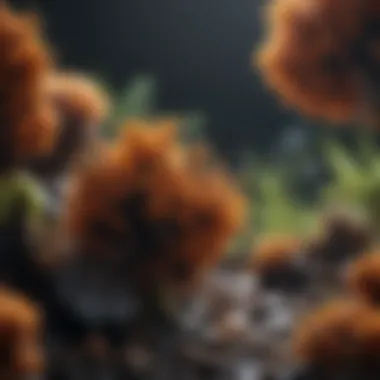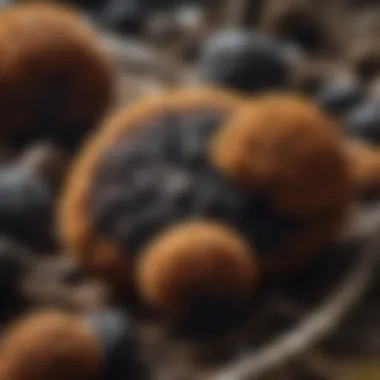Chaga Mushroom and Cancer: An In-Depth Analysis


Intro
Chaga mushroom, scientifically named Inonotus obliquus, has sparked significant interest in the realms of natural remedies and oncology. This fungus, commonly found on birch trees in cold climates, is revered not just for its unique appearance but also for its range of bioactive compounds. Recent studies have begun to unravel its potential therapeutic properties, especially in relation to cancer treatment. This article aims to provide a comprehensive analysis of the relationship between chaga mushroom and cancer, highlighting its active components, mechanisms of action, current research findings, and clinical implications.
Understanding the possible effects of chaga on cancer is crucial for scholars, healthcare professionals, and those interested in alternative therapies. As the exploration continues, it is vital to assess the evidence, weigh the findings, and consider the implications for practice. This article addresses these topics systematically, laying a foundation for future research and exploration.
Key Findings
Major Results
Recent studies indicate that chaga mushroom may possess significant anti-tumor activity. The primary active compounds in chaga include triterpenes, polysaccharides, and phenolic compounds. These components are implicated in various biological activities that may counteract cancer progression. For instance:
- Antioxidant Properties: Chaga is known for its strong antioxidant properties, which can protect cells from oxidative stress, a contributor to cancer development.
- Immune Modulation: Research has shown that chaga can enhance the immune response, potentially supporting the body in fighting cancerous cells.
- Apoptosis Induction: Some research suggests that chaga could promote apoptosis, the programmed cell death that is often disrupted in cancer cells.
Discussion of Findings
The implications of these findings are noteworthy. While in vitro studies demonstrate the efficacy of chaga in inhibiting cancer cell growth, clinical trials are required to ascertain its true potential in human populations. The bioavailability of chaga's active compounds and their interactions with conventional cancer therapies must be carefully examined. Understanding how chaga can complement existing treatment protocols could offer a holistic approach to cancer care.
"The role of natural products like chaga in cancer treatment could redefine therapeutic strategies and patient outcomes."
Methodology
Research Design
The exploration of chaga's impacts on cancer utilizes a multi-faceted research design, involving both laboratory-based studies and clinical evaluations. The blend of qualitative and quantitative approaches ensures a thorough understanding of the effects and mechanisms at play.
Data Collection Methods
Data collection involves systematic reviews of existing literature, controlled laboratory experiments, and observational studies. This diverse methodology allows for the accumulation of comprehensive insights into chaga's therapeutic effects. Notably, researchers focus on:
- Cell Cultures: In vitro experiments assess how chaga compounds affect cancer cell lines.
- Animal Models: Studies involving animal subjects help evaluate the effects in a biological context.
- Human Trials: Ongoing trials seek to gather data on the efficacy and safety of chaga supplementation in cancer patients.
Through these varied methods, the inquiry into chaga's role in cancer treatment continues to evolve, revealing new dimensions and potentials.
Understanding Chaga Mushroom
Chaga mushroom, a fungus found primarily on birch trees, has gained attention in recent years for its potential health benefits, particularly in cancer prevention and treatment. Its interest has spurred scientific research and fascination within the holistic health community. By investigating the properties and characteristics of Chaga, one can understand its relevance in the context of cancer. This analysis only aims to highlight the benefits and considerations when incorporating Chaga mushroom into health regimens.
Botanical Characteristics
Chaga, scientifically known as Inonotus obliquus, is a parasitic fungus characterized by its irregular, dark, and woody appearances. Unlike many mushrooms, Chaga does not possess the typical umbrella shape. Instead, it grows as a black, hardened mass called sclerotium on the trunks of birch trees, often resembling a burn mark. The internal structure of Chaga is lighter in color, showing a soft, orange-brown hue. This unique morphology suggests adaptations helping it thrive in harsh environments.
The chemical bioactive compounds found in Chaga contribute significantly to its therapeutic properties. Studies indicate that Chaga contains essential polysaccharides, triterpenes, and phenolic compounds, which may attribute to its reputation as a natural remedy. These compounds play a role in immune support and may exhibit anticancer activities.
Geographic Distribution
Chaga mushroom predominantly thrives in cooler climates, especially in regions with significant birch tree populations such as Northern Europe, Russia, North America, and parts of East Asia. Its growth is often linked to specific environmental conditions, leading to its availability in forested areas rich with the appropriate tree species. For instance, in Russia, Chaga has been a traditional medicine for centuries, whereas its popularity in Western herbal applications is more recent. Understanding its geographic distribution helps researchers determine both the practical applications and conservation measures needed to ensure its sustainable harvesting.
Traditional Uses
Historically, Chaga has been utilized across various cultures as a medicinal remedy. In traditional Siberian medicine, Chaga is valued for its ability to boost immunity and combat ailments. The indigenous populations of northern regions have made teas and tinctures with Chaga, believing in its health benefits for centuries.
In contemporary settings, many health enthusiasts integrate Chaga into their daily routines as teas, powders, and supplements. Its reputation as a health tonic grows as more individuals explore its potential therapeutic properties. The continued use of Chaga has fostered interest in clinical studies to validate these traditional claims scientifically.
"Exploring natural remedies like Chaga allows a bridge between traditional knowledge and modern science, offering insights into integrative health practices."
Understanding Chaga mushroom forms the foundation for deeper exploration into its chemical composition and potential role in cancer treatment, which will be addressed in subsequent sections.


Chemical Composition of Chaga
The chemical composition of chaga mushroom is fundamental to understanding its potential therapeutic applications, particularly in the context of cancer treatment. Analyzing its bioactive compounds can reveal important insights into how chaga exerts its effects on the body, specifically within oncological frameworks. Recognizing these components not only enhances our knowledge but also aids in evaluating their practical value in clinical and complementary settings.
Key Bioactive Compounds
Polysaccharides
Polysaccharides are among the most notable compounds found in chaga. They form a crucial part of its chemical profile due to their bioactive properties. Polysaccharides are known for their ability to enhance immune function, which is particularly relevant for cancer patients facing immunosuppression.
These carbohydrates are complex, consisting of long chains of sugar molecules. Their unique structure allows them to interact with immune cells, promoting the activation of various immune responses. This characteristic makes polysaccharides a beneficial component in the fight against cancer, as they may help improve the body’s natural defense mechanisms. Additionally, polysaccharides have shown potential in exhibiting antioxidant properties, reducing oxidative stress that can lead to cancer progression.
However, their effectiveness can be influenced by several factors, including extraction methods and dosage. Therefore, while polysaccharides present advantages, more research is necessary to optimize their use.
Phenolic Compounds
Phenolic compounds in chaga contribute significantly to its overall therapeutic potential. These compounds are known for their strong antioxidant activities, which help mitigate oxidative stress associated with cancer development and progression.
A key characteristic of phenolic compounds is their ability to scavenge free radicals, which can damage cells and DNA. This antioxidant capability is valuable because it may lower the risk of mutations that lead to cancer. Moreover, phenolic compounds have been studied for their anti-inflammatory effects, which further contribute to their importance in cancer prevention and treatment.
Their unique feature lies in their diverse range, with various types of phenolic compounds offering different benefits. This diversity can be an advantage, providing a more holistic approach to integrating chaga into cancer care. Nevertheless, balancing phenolic intake while ensuring bioavailability is a concern that requires attention in future studies.
Betulin and Betulinic Acid
Betulin and betulinic acid are triterpenoids present in chaga that have attracted interest in cancer research. These compounds are recognized for their potential cytotoxic properties against various cancer cell lines. Betulinic acid, in particular, has been noted for its ability to induce apoptosis in cancer cells, providing a direct mechanism of action against tumors.
The primary characteristic of these compounds lies in their selective toxicity—targeting cancer cells while sparing healthy ones. This effectiveness makes them a valuable focus in developing adjunct therapies for cancer treatment. Furthermore, betulin and betulinic acid can contribute to lowering inflammation, which is crucial for creating an environment unfriendly to cancer cell growth.
However, as with other bioactive compounds, the therapeutic potential of betulin and betulinic acid can vary based on formulation and delivery methods, highlighting the need for careful consideration in clinical applications.
Nutritional Profile
Chaga's nutritional profile further complements its chemical composition. It contains proteins, a range of essential amino acids, and vitamins such as B-complex and D. It also provides trace minerals such as zinc, manganese, and copper, all of which play roles in maintaining overall health and supporting bodily functions, including immune response.
Bioavailability and Absorption
The bioavailability of chaga's bioactive compounds is crucial for their effectiveness. Factors affecting bioavailability include the form in which chaga is consumed (e.g., tea, powder, extract) and the preparation methods used. Understanding how these compounds are absorbed can inform optimal ways to incorporate chaga into diets, maximizing its health benefits.
Chaga Mushroom and Cancer Research
Research into the relationship between Chaga mushroom and cancer is gaining significant attention in both scientific and medical communities. This section aims to highlight the relevance of Chaga mushroom as a potential counterpart in cancer therapy. Understanding Chaga's bioactive compounds and their mechanisms of action can contribute substantially to the broader conversation about complementary therapies in oncology. The exploration here focuses on specific mechanisms through which Chaga mushroom may exert effects on cancer cells, alongside insights from various studies.
Mechanisms of Anticancer Activity
The potential anticancer properties of Chaga mushroom can be attributed to several mechanisms. Each mechanism plays its part in the process of combating cancer or supporting the body’s immune functions.
Apoptosis Induction
Apoptosis induction is a critical process in regulating cell death, particularly in the context of cancer treatment. Chaga mushroom has shown promise in promoting apoptosis in malignant cells. The significance of apoptosis induction lies in its ability to trigger programmed cell death in cancer cells, which is essential for controlling tumor growth. In this article, this mechanism is highlighted as a beneficial aspect of Chaga's role in cancer therapy. Its unique feature is the ability to selectively target cancerous cells while sparing healthy cells, which is an advantage in minimizing side effects often seen with traditional therapies.
Immune Modulation
Immune modulation refers to the modification of the immune response, which can enhance the body’s ability to fight cancer. Chaga mushroom contributes to immune modulation effectively by boosting immune cell activity. This characteristic supports the notion of Chaga as a popular choice within cancer care discussions. The unique feature of immune modulation provided by Chaga is its potential to improve the efficacy of conventional treatments and offers patients a more holistic approach to therapy. However, attention must be given to how this may vary individually, posing both advantages and disadvantages across different patient profiles.
Antioxidant Effects
The antioxidant effects of Chaga mushroom play a vital role in its cancer-fighting potential. By combatting oxidative stress, antioxidants help prevent cellular damage. This property is essential since oxidative stress is linked to the development of cancer. Chaga’s rich composition of antioxidants offers considerable benefits, making it a valuable addition to cancer research. Moreover, the ability of antioxidants to protect healthy cells from damage highlights a unique feature of Chaga, reinforcing its advantages in integrating natural compounds into cancer therapies. Nevertheless, reliance solely on antioxidants should be carefully considered to avoid potential disadvantages, such as overexpression that may hinder normal cellular responses.


In Vitro Studies
In vitro studies have indicated various supportive roles of Chaga mushroom against cancer cells. Such studies investigate cell cultures in controlled environments, providing preliminary insights into its effects. The results generally point towards the effectiveness of Chaga extracts in inhibiting cell proliferation and affecting cancer cell signaling pathways. Understanding these findings can guide future explorations into more comprehensive approaches that incorporate Chaga in treatments.
In Vivo Studies
In vivo studies are essential for validating the results observed in vitro. These studies examine the effects of Chaga in living organisms, providing a broader context on its potential efficacy in cancer care. Early results indicate that when administered alongside traditional cancer treatments, Chaga may bolster overall treatment outcomes and improve longevity. Continued research in this area remains critical to confirm and expand upon the effects and applications of Chaga mushroom in cancer therapy.
Current Clinical Evidence
The topic of current clinical evidence regarding chaga mushroom and its potential effects in cancer treatment is essential to understanding its place in modern medicine. Clinical evidence verifies the promises made in laboratory and preclinical studies. It helps to establish the validity of chaga's therapeutic properties. This section examines the advancements made through clinical trials, notable case studies, and insights from experts in the field. Collectively, this information aids in evaluating chaga mushroom as a viable complementary treatment option in oncology.
Published Clinical Trials
Published clinical trials are a cornerstone of evidence that contributes to the overall understanding of chaga's efficacy in combating cancer. Various studies have investigated the bioactive components in chaga and their potential to inhibit tumor growth.
Research focused on how chaga polysaccharides interact with cancer cells shows promising outcomes. For instance, many trials have highlighted the role of these compounds in promoting apoptosis. Apoptosis is a form of programmed cell death crucial for eliminating malignant cells.
Moreover, trials have been conducted to assess chaga's immune-modulating capabilities in cancer patients. Researchers have documented improvements in immune system response leading to enhanced anti-tumor activity. These results suggest that, for some patients, incorporating chaga into their treatment could amplify the effects of conventional therapies.
Some key points from clinical trials include:
- Efficacy in enhancing immune response.
- Potential reduction of side effects from traditional cancer treatments.
- Improvement in overall patient well-being when combined with existing treatment protocols.
Case Studies
Case studies provide real-world insights into the effects of chaga mushrooms in cancer therapy. They serve as narratives of individual experiences, showcasing how chaga may assist cancer patients in their journeys.
One documented case involved a patient with late-stage lung cancer who integrated chaga into their daily regimen. This patient noted a significant decrease in fatigue levels and an improvement in quality of life. Although individual results can vary, such case studies illustrate the potential benefits of chaga as a complementary treatment.
Another case highlighted the experience of a breast cancer survivor who used chaga alongside chemotherapy. The patient reported fewer side effects, suggesting that chaga might mitigate some harsh reactions from the chemotherapy regimen.
These case studies emphasize:
- The importance of patient-reported outcomes in assessing therapy effectiveness.
- The potential of chaga to enhance overall health during rigorous cancer treatments.
Expert Opinions
Expert opinions form a vital aspect of understanding the clinical relevance of chaga mushroom. Oncologists and herbal medicine specialists often express cautious optimism about its role in cancer treatment.
Some experts advocate for more rigorous studies, insisting on a comprehensive analysis of chaga's long-term effects. They acknowledge that while preliminary evidence is encouraging, further investigations are necessary to fully validate its worth. Collaborative research combining both traditional oncology and alternative therapies is recommended to provide a balanced view.
Medical professionals emphasize the importance of integrating chaga in consultation with healthcare providers. Doing so ensures that patients receive guidance tailored to their individual treatment plans.
In summary, current clinical evidence illustrates the multifaceted role of chaga mushroom in cancer care. Through clinical trials, case studies, and expert input, a clearer picture emerges of its potential benefits and limitations in oncological treatment.
Safety and Side Effects
Understanding the safety and potential side effects of chaga mushroom is crucial for anyone considering its use in cancer treatment. Although chaga is often lauded for its health benefits, it is also important to recognize the risks. This section outlines concerns related to potential toxicity, possible drug interactions, and recommendations for safe use.
Potential Toxicity
Chaga mushroom, while generally recognized as safe, can exhibit potential toxicity under certain conditions. Studies suggest that high doses may lead to various health issues. For example, excessive consumption has been linked to liver injury in some individuals. It is vital to consider how the mushroom interacts with existing medical conditions, especially those affecting the liver.
Toxic components may include:
- High oxalate levels, which could promote kidney stones.
- Concentrations of betulinic acid, if consumed in large amounts, could lead to adverse effects.


These factors highlight the need to approach chaga mushroom consumption with caution, particularly for vulnerable populations or those with pre-existing health conditions.
Drug Interactions
The potential for drug interactions is an important aspect of chaga mushroom consumption. Chaga can affect the metabolism of certain medications, altering their efficacy. Some known interactions include:
- Anticoagulants: Chaga may enhance the effects of blood thinners, increasing the risk of bleeding.
- Diabetes medications: The mushroom could lower blood sugar levels, heightening the effects of insulins or other diabetic drugs.
- Immunosuppressants: Since chaga has immune-modulating properties, it may interfere with drugs designed to suppress immune system activity.
Patients should always consult healthcare professionals prior to adding chaga to their regimens, especially when taking these medications.
Recommendations for Use
For those considering the incorporation of chaga mushroom into their health practices, specific recommendations should guide its use.\n
- Start with small doses: Begin with a lower amount to monitor for any adverse reactions.
- Consult a healthcare professional: Seek advice from a qualified doctor, especially if on medication or managing chronic conditions.
- Observe personal reactions: Keep track of any side effects that may emerge after starting chaga, even at small doses.
- Consider quality and source: Ensure that the chaga sourced is high quality and free from contaminants, reducing the risk of toxicity.
"While chaga mushroom shows promise as a complementary therapy, safety should always come first. Always inform your healthcare provider about all supplements you are taking."
Following these steps can help ensure that chaga mushroom is used safely and effectively, minimizing risk while exploring its potential benefits in cancer care.
Complementary Therapy in Cancer Care
Complementary therapies are gaining traction as integral components in cancer care. They provide additional support alongside conventional treatments, such as surgery, chemotherapy, and radiation therapy. This section discusses the relevance of integrating chaga mushroom as a complementary therapy in cancer care. It aims to highlight specific benefits, considerations, and practical applications.
Integrating Chaga into Treatment Plans
Chaga mushroom can be integrated into treatment plans in various ways. Its rich profile of bioactive compounds suggests potential therapeutic benefits in enhancing the efficacy of standard cancer treatments. Some health professionals consider including chaga as a dietary supplement, recommending it for its antioxidant properties, which may help in neutralizing free radicals generated by chemotherapy.
When introducing chaga, it is essential to evaluate the patient’s overall health and any existing treatment protocols. Many oncologists suggest consuming it as a tea or in powder form, either mixed into foods or smoothies. Dosage can vary based on individual circumstances, and it is prudent to consult with a healthcare provider for personalized guidance. Overall, the goal is to formulate a plan that leverages chaga's potential while remaining cohesive with the primary treatment objectives.
Patient Perspectives
The patient experience is vital in evaluating the effectiveness of complementary therapies. Anecdotal evidence indicates that many patients using chaga report feeling more energetic and experiencing less discomfort during treatments. For instance, some have mentioned improved digestive health and enhanced emotional well-being. Such qualitative benefits, while not universally documented, underscore the importance of considering patient perspectives in therapeutic strategies.
Moreover, engaging patients in discussions about their treatment preferences can foster a sense of autonomy. The incorporation of chaga can be a boon for patients seeking natural supplementary options, particularly if they feel overwhelmed by conventional treatment regimens. Being open about choices can enhance commitment to the overall treatment plan and lead to better health outcomes.
Consulting Healthcare Professionals
Consulting with healthcare professionals is critical when considering chaga mushroom in cancer therapy. Oncologists and dietitians can provide tailored insights and recommendations based on a patient's medical history and ongoing treatments. Discussions should focus on the potential benefits and risks associated with chaga use.
It is also essential for patients to disclose any supplements they are taking to avoid conflicts with prescribed medications. Transparency ensures a collaborative approach to treatment. Some established sources may even provide recommendations for integrating natural supplements without compromising the efficacy of conventional therapies.
The integration of chaga mushroom as a complementary therapy represents a nuanced approach in cancer care, necessitating open dialogue between patients and healthcare professionals for optimal outcomes.
Future Research Directions
The exploration of chaga mushroom's potential in cancer treatment is a rapidly advancing field. However, there are significant areas that require attention and further investigation to fully understand its therapeutic role. This section highlights the critical importance of identifying future research directions pertaining to chaga mushroom and its impact on cancer therapy. By pinpointing specific knowledge gaps and suggesting potential studies, researchers and professionals can advance the current state of understanding.
Current Knowledge Gaps
Despite the promising findings surrounding chaga mushroom, several knowledge gaps persist. Firstly, the specific mechanisms by which its bioactive compounds exert anticancer effects remain poorly understood. Further studies are needed to clarify the pathways involved, including the specific cellular targets and the molecular interactions with cancer cells.
Secondly, there is limited data on the efficacy of chaga mushroom in different types of cancers. Most studies have focused on certain malignancies, leaving others inadequately researched. Additionally, the optimal dosage and administration methods for various patient demographics have not been thoroughly evaluated. Understanding how metabolic differences across populations may affect chaga's bioavailability and effectiveness is crucial.
Furthermore, clinical relevance is often hindered by a lack of standardized forms of chaga in research. This inconsistency complicates comparisons across studies and raises questions regarding the reproducibility of results. The scientifically accepted administration protocols need to be established, possibly including dosage forms like extracts, capsules, or teas.
Potential Studies to Pursue
To address these gaps, a series of targeted studies could enhance knowledge about chaga mushroom and its anticancer properties. Proposed research avenues include:
- Mechanistic Studies: Conduct in-depth investigations into the specific pathways influenced by chaga's bioactive compounds, such as the behavior of tumor suppressor genes and oncogenes.
- Clinical Trials: Implement randomized controlled trials in diverse cancer populations to determine the efficacy of chaga mushroom across various cancer types. Such studies should focus on comparing chaga with placebo or traditional treatment regimens.
- Pharmacokinetics: Studies examining the pharmacokinetics of chaga could shed light on how its compounds are absorbed, metabolized, and eliminated in the body. This research is vital to ascertain the best methods of administration for optimal therapeutic effects.
- Synergistic Effects: Exploring how chaga can be used in conjunction with established cancer therapies (like chemotherapy or radiotherapy) may provide insights into its potential role as a complementary treatment.
- Longitudinal Studies: Research that tracks the long-term outcomes of chaga treatment in cancer patients could uncover its effects over time and establish safer usage parameters.
"Understanding the complexities and potentialities of chaga mushroom may lead to breakthroughs in cancer treatment strategies that are both innovative and effective."
Future investigations must strive to fill these gaps to realize chaga mushroom’s full potential and integrate its benefits into mainstream cancer therapy.



